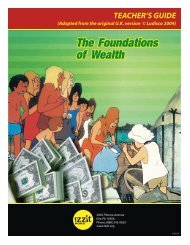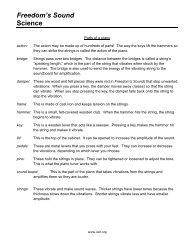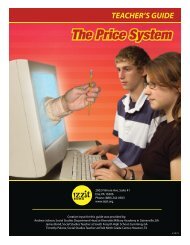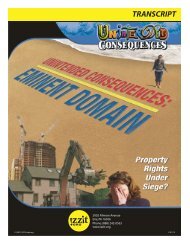Risk & Reward - Izzit.org
Risk & Reward - Izzit.org
Risk & Reward - Izzit.org
You also want an ePaper? Increase the reach of your titles
YUMPU automatically turns print PDFs into web optimized ePapers that Google loves.
TRANSCRIPT© 2013 izzit.<strong>org</strong>2002 Filmore AvenueErie, PA 16506Phone: (888) 242-0563www.izzit.<strong>org</strong>V. 01/13
<strong>Risk</strong> and <strong>Reward</strong>TranscriptFor a list of additional resources to use with this video go towww.izzit.<strong>org</strong>/products and click on the <strong>Risk</strong> and <strong>Reward</strong> videoHOST: When it was opened here in Chicago in 1930, this was the largest building in theworld…four million square feet! It is so large it even has its own zip code.This...is the Merchandise Mart. It’s still the home of many wholesale businesses… butthese days it has a new lease on life as home to “Business Incubators.” Like this one,called 1871.Entrepreneurs who want to start a business gather here early on to work on business plansand look for money. They rent space and facilities in the hope that their entrepreneurialidea will attract people with money…people called “Venture Capitalists.”I’m talking about people who are willing to risk lots of their money in order to helpothers get started.It works like this: One person has a great idea but no start-up money. Another person hasstart-up money but no great idea. What happens when you put them together?Sometimes they fail, but sometimes they succeed big time. And when they do, we allprofit.That cell phone of yours…your computer, and many of the medicines that keep you well?They wouldn’t have been invented if it hadn’t been that a few people were willing to takea chance on a new idea and to place their personal fortunes at risk.And don’t f<strong>org</strong>et, along the way the investments in these companies created lots of jobsand helped grow our American economy.Politicians try to create jobs with government programs. They make investments withtaxpayers’ money, but suffer no consequences if those investments go south, and jobsdisappear.The people you’re about to meet invested their own money in what they thought was awinning idea; and the risk of failure hung over every investment.So watch and judge for yourself. Shouldn’t we encourage our private inventors and theinvestors who take all the risk?(VARIOUS VOICES)The risks were just enormous!They came to me with no business plan.1
…willing to risk everything.You have to be a street fighter out there.A million dollars…Ten billions dollars…Intel, Apple, Genentech, Cisco…Good markets…Create companies…Rolling companies…The sky’s the limitThe rest is history…DR. HERBERT BOYER: I was in my laboratory probably talking to students…Here’s a call comes out of the blue… this young guy wanted to know if the technologywas ready to be commercialized.Then he said the magic word, he says “I have access to some money that would allow usto get started.” And I said “Okay.”I said, “Where does the money originate?” and he said “I’m a junior member at a venturecapital firm.” I went to look up what “Venture Capital” meant. Well, I didn’t…I’d neverheard of it before.TOM PERKINS: I don’t know how to write a business plan, I can only tell you how weread them, and we start at the back, and if the numbers are big, we look at the front to seewhat kind of business it is.DON VALENTINE: You have to look at the way conventional wisdom works, andabandon it.No one has ever accused me of underestimating… myself.ARTHUR ROCK: Jobs and Wozniak came up to see me.Steve Jobs was so visionary and so bright…I had to fire him, though.NARRATOR: Back in the spring of 1957, Arthur Rock was just a junior banker on WallStreet. But then one day, an unsolicited letter arrived at the office. The letter wasunusual, and no one else at his brokerage firm knew what to do with it. It was a cry forhelp, and it would forever change the trajectory of Arthur Rock’s life.ROCK: You got to be lucky. Everybody’s going to be lucky at some time or another.Thing I say is, I was lucky to be lucky early. (Laughs)NARRATOR: The letter on Arthur Rock’s desk had come from eight engineers inCalifornia… a group of brilliant young men who would soon become known as “TheTraitorous Eight.”2
GORDON MOORE: We were young guys…a bunch of young engineers, and…andscientists mostly…working together at Shockley Semiconductor.Things had deteriorated at Shockley Lab…He was a very difficult person to work with,and a group of us started considering the possibility, at least, of leaving.ROCK: “A group feeling to the effect that, rather than leave one by one, we believe weare much more valuable to an employer as a group.”These were, by their resumes, very superior people, and I thought, “Well gee, maybethere’s something here, something more valuable than just to be an employee.”NARRATOR: That “something” that Arthur saw, inspired him to step out of hisordinary role as a Wall Street banker.Arthur Rock had to get creative about finding capital for the Traitorous Eight.MOORE: In fact we sat down with the Wall Street Journal…ROCK: Looking for companies to ask to invest in these eight fellas in forming a newcompany.MOORE: I think we had 35 companies…ROCK: All of them said no…no!NARRATOR: The attempt to start a new company might have ended then and there,with the Traitorous Eight returning to their job search and Arthur Rock admittingdefeat…but then, Arthur received one last lead.ROCK: We were pretty much at wit’s end, and somebody suggested that I see ShermanFairchild.Sherman Fairchild was an entrepreneur himself, and also a very wealthy man.He right away saw the possibilities, and decided that Fairchild Camera and Instrumentwould invest the million and a half dollars we were looking for.NARRATOR: With the $1.5 million Arthur raised, the Traitorous Eight started FairchildSemiconductor in Mountain View, California, a sleepy rural town 35 miles south of SanFrancisco.Fairchild was the first company to manufacture the sophisticated silicon chips that wouldpower computers, rockets and spacecraft… paving the way for the high-tech age.3
In time, the fruit orchards surrounding Fairchild would give way to electronicscompanies, and the area would become famous as the Silicon Valley.VALENTINE: When I started in the venture business, it never occurred to me that wewould have multiple funds that would easily exceed a billion dollars.NARRATOR: In 1972, Don Valentine decided to trade on his connections in thesemiconductor industry, and went in search of capital to start a venture fund.Rebuffed by Wall Street, Don Valentine found a mentor in a southern California mutualfund manager, who staked the money for Don’s first venture fund.VALENTINE: I’m not interested in entrepreneurs who will do it our way. I’m interestedin entrepreneurs who have a vision of doing something consequential, preferably thatbecomes big.NEWSCASTER: For most people, there is something intimidating about the idea ofinteracting with a computer, but that is what’s happening here.VALENTINE: Atari had one of Silicon Valley’s absolutely larger than life personalitiesleading it – Nolan K. Bushnell.NARRATOR: Bushnell was a young engineer working for game manufacturer NuttingAssociates, when he decided to strike out on his own in 1972.NOLAN BUSHNELL: I said, “You know, I can run a company, and I won’t make anyof the same mistakes these idiots are doing.”NARRATOR: The first game Atari designed was Pong…Nolan took a prototype of thegame, strapped it to his back, and placed it in a bar in Sunnyvale, California.By the next morning, customers were lined up outside clamoring for a chance to play.BUSHNELL: We put it on location; it earned a lot of money…Production soared, and there seemed to be an insatiable appetite for the coin-operatedgame.NARRATOR: From the outside, Atari looked like a wildly successful company,producing an endless stream of popular games, but there was one key problem.BUSHNELL: The company was started with 250 dollars. And so, we never had anymoney.NARRATOR: In 1974, Atari was flirting with bankruptcy and desperately neededfinancial help, but Nolan found the traditional channels…off limits.4
VALENTINE: Banks lend on assets… so, “Do you have a house? I’ll give you amortgage. Do you have a car? I’ll give you a loan on your car.”Nolan had no basis for a bank to be comfortable.NARRATOR: Don might have passed on Atari had Nolan not shown him a surprisingnew product in development: Home Pong.Atari’s engineers had discovered they could get the entire Pong game down to the size ofa shoebox.At the time, playing video games at home was a revolutionary concept.BUSHNELL: We showed Don our plans for the home games… he finally decided therewas a business there.VALENTINE: Fabulous product… giant market…BUSHNELL: He used to say, “You know, the coin-op business, you think it’s big?” Hesays, “You ain’t seen nothin’.”VALENTINE: Huge.Once we decided to finance Atari, it was a matter of trying to figure out who else wouldinvest in it.One of our investors was a very big shareholder of Sears. And they facilitated theintroduction to the buyer at Sears who would buy a product like this. I think he wascharmed by Nolan and found this experiment might be fun.(Song)♫Everybody’s talking about a new way of shopping… do you want to lose your mind? ♫NARRATOR: Home Pong hit the shelves just in time for the 1975 Christmas season.BUSHNELL: And of course, the rest is history.(Song)♫ When he plays a game from Atari, have you played Atari today? ♫PERKINS: At the time we started Genentech, there was no such thing as geneticengineering, and to take the idea of commercializing gene splicing, the risks were justenormous…I said well, you know, “What if God or Darwin won’t let us make a new lifeform?”5
HERB BOYER: It came out of the blue for me, I had not been thinking about starting acompany.I thought I was going to die at the lab bench with a pipette in my mouth. But Bob called,and he wanted to know if the technology was ready to be commercialized.PERKINS: Bob Swanson, I think, was the most prescient individual I’ve ever met.Once he understood what the potential technology was in genetic engineering, he got thewhole picture, way ahead of anybody else. And he called Professor Boyer at theUniversity of California. Boyer said, “I’ll give you five minutes.” And it turned into, youknow, many hours.BOYER: In those days funding for research was…difficult.PERKINS: Over the next couple of weeks, Swanson persuaded Boyer to take the idea ofgene splicing into some sort of a commercial operation.BOYER: So we go into one of the Embarcadero Towers, and we go up to the top floor,and you can look out over the world. It was something like out of a movie, you know,holy smoke! Here was this rich guy, you know, talking to us about science, and fundingscience, I paid attention.PERKINS: They wanted to raise about three million dollars to build the factory, hire thepeople, and then see if it would work. But underlying it all was the…the tremendous riskfactor of, you know, would it be possible?It was pure research, you know, and everybody knows that venture capitalists shouldn’topenly fund pure research. So my idea in everything has always been to try to put the riskup front, and get rid of the risk as fast as you possibly can.We changed the business plan. I persuaded them to subcontract the experiment to twodifferent institutions.NARRATOR: By subcontracting, Tom Perkins eliminated the need to buy equipment,build a lab, and hire staff.The estimated three million dollar start-up costs were reduced to just 250thousand…Kleiner Perkins put up the money and Genentech was in business.PERKINS: It was Bob Swanson and a checkbook… sitting in our office here. That wasGenentech.NARRATOR: Boyer and Swanson set out to create human insulin. But to test theirconcept, they began with a less complex hormone. City of Hope Medical Center in LosAngeles would try to engineer a gene for that hormone.6
Then, UC San Francisco would splice that gene into bacteria to produce the hormone insignificant amounts.PERKINS: After a very long time, City of Hope succeeded in making the gene, and thenwe transported the gene. Bob had it in his pocket, up to University of California, andHerb Boyer inserted it into the bacterial host…then it worked.So we had our breakthrough.That was the first time in history that mankind had ever made an artificial, well, let’s justsay an, “Artificial Bacteria.”NEWSCASTER: Most doctors agree that genetic engineering will be the source of mostdrugs in the next decade.NEWSCASTER: As scientists look ahead, they see a myriad of products, new vaccines…BOB SWANSON: We haven’t scratched the surface yet, in terms of new hormones andmolecules that the body produces itself to keep itself healthy.BOYER: You know…it wasn’t my goal to start an industry. My goal was to make surethe science got translated into an endeavor that would be useful to people.PERKINS: In all the things I’ve done, I think I’m most proud of Genentech, because it…well, saved hundreds of thousands of people’s lives,Well, isn’t it great if you can make money, and change the world for the better at thesame time?(VARIOUS VOICES)We need guys with new ideas about how to do things…All these ideas…You gotta get to the frontier…Do something, build a company…The entrepreneurial spirit…The entrepreneurial spirit…Entrepreneurship…Making the world go round…Hard-working, visionary…Change the way people work; educate their kids…And you can do it…For a list of additional resources to use with this video go towww.izzit.<strong>org</strong>/products and click on the <strong>Risk</strong> and <strong>Reward</strong> video7
We are very interested to learnhow you use our material. Pleaseshare your experiences or lessonplan ideas by visiting usat www.izzit.<strong>org</strong>.2002 Filmore AvenueErie, PA 16506Phone: (888) 242-0563www.izzit.<strong>org</strong>
















